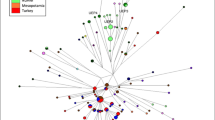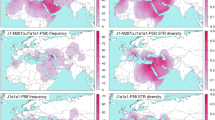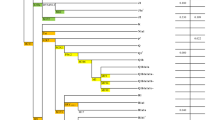Abstract
Islam is the second most practiced religion in India, next to Hinduism. It is still unclear whether the spread of Islam in India has been only a cultural transformation or is associated with detectable levels of gene flow. To estimate the contribution of West Asian and Arabian admixture to Indian Muslims, we assessed genetic variation in mtDNA, Y-chromosomal and LCT/MCM6 markers in 472, 431 and 476 samples, respectively, representing six Muslim communities from different geographical regions of India. We found that most of the Indian Muslim populations received their major genetic input from geographically close non-Muslim populations. However, low levels of likely sub-Saharan African, Arabian and West Asian admixture were also observed among Indian Muslims in the form of L0a2a2 mtDNA and E1b1b1a and J*(xJ2) Y-chromosomal lineages. The distinction between Iranian and Arabian sources was difficult to make with mtDNA and the Y chromosome, as the estimates were highly correlated because of similar gene pool compositions in the sources. In contrast, the LCT/MCM6 locus, which shows a clear distinction between the two sources, enabled us to rule out significant gene flow from Arabia. Overall, our results support a model according to which the spread of Islam in India was predominantly cultural conversion associated with minor but still detectable levels of gene flow from outside, primarily from Iran and Central Asia, rather than directly from the Arabian Peninsula.
Similar content being viewed by others
Log in or create a free account to read this content
Gain free access to this article, as well as selected content from this journal and more on nature.com
or
Accession codes
References
Schimmel A : Islam in India and Pakistan. Leiden: Brill Academic Publishers, 1982.
Robb P : A History of India. Hampshire: Palgrave Macmillan Publishers, 2002.
Naqvi S : The Iranian Afaquies contributions to the Qutub Shahi and Adil Shahi Kingdoms. Hyderabad: Hussain Book Shop, 2003.
Papiha SS : Genetic variation in India. Hum Biol 1996; 68: 607–628.
Lanchbury JS, Agarwal SS, Papiha SS : Genetic differentiation and population structure of some occupational caste groups in Uttar Pradesh, India. Hum Biol 1996; 68: 655–678.
Aarzoo SS, Afzal M : Gene diversity in some Muslim populations of North India. Hum Biol 2005; 77: 343–353.
Balgir RS, Sharma JC : Genetic markers in the Hindu and Muslim Gujjars of Northwestern India. Am J Phys Anthropol 1988; 75: 391–403.
Terreros MC, Rowold D, Luis JR, Khan F, Agrawal S, Herrera RJ : North Indian Muslims: enclaves of foreign DNA or Hindu converts? Am J Phys Anthropol 2007; 133: 1004–1012.
Gutala R, Carvalho-Silva DR, Jin L et al: A shared Y-chromosomal heritage between Muslims and Hindus in India. Hum Genet 2006; 120: 543–551.
Eaaswarkhanth M, Dubey B, Meganathan PR et al: Diverse genetic origin of Indian Muslims: evidence from autosomal STR loci. J Hum Genet 2009; 54: 340–348.
Abu-Amero KK, González AM, Larruga JM, Bosley TM, Cabrera VM : Eurasian and African mitochondrial DNA influences in the Saudi Arabian population. BMC Evol Biol 2007; 7: 32.
Cadenas AM, Zhivotovsky LA, Cavalli-Sforza LL, Underhill PA, Herrera RJ : Y-chromosome diversity characterizes the Gulf of Oman. Eur J Hum Genet 2008; 16: 374–386.
Quintana-Murci L, Chaix R, Wells RS et al: Where West meets East: the complex mtDNA landscape of the Southwest and Central Asian corridor. Am J Hum Genet 2004; 74: 827–845.
Regueiro M, Cadenas AM, Gayden T, Underhill PA, Herrera RJ : Iran: tricontinental nexus for Y-chromosome driven migration. Hum Hered 2006; 61: 132–143.
Enattah NS, Jensen TG, Nielsen M et al: Independent introduction of lactase-persistence alleles into human populations reflects different history of adaptation to milk culture. Am J Hum Genet 2008; 82: 57–72.
Enattah NS, Trudeau A, Pimenoff V et al: Evidence for still ongoing convergence evolution of the lactase persistence T-13910 alleles in humans. Am J Hum Genet 2007; 81: 615–625.
Metspalu M, Kivisild T, Metspalu E et al: Most of the extant mtDNA boundaries in South and Southwest Asia were likely shaped during the initial settlement of Eurasia by anatomically modern humans. BMC Genet 2004; 5: 26.
Cordaux R, Saha N, Bentley GR, Aunger R, Sirajuddin S, Stoneking M : Mitochondrial DNA analysis reveals diverse histories of tribal populations from India. Eur J Hum Genet 2003; 11: 253–264.
Kivisild T, Bamshad MJ, Kaldma K et al: Deep common ancestry of Indian and Western-Eurasian mitochondrial DNA lineages. Curr Biol 1999; 9: 1331–1334.
Abu-Amero KK, Larruga JM, Cabrera VM, González AM : Mitochondrial DNA structure in the Arabian Peninsula. BMC Evol Biol 2008; 8: 45.
Melton T, Clifford S, Martinson J, Batzer M, Stoneking M : Genetic evidence for the proto-Austronesian homeland in Asia: mtDNA and nuclear DNA variation in Taiwanese aboriginal tribes. Am J Hum Genet 1998; 63: 1807–1823.
Yao YG, Nie L, Harpending H, Fu YX, Yuan ZG, Zhang YP : Genetic relationship of Chinese ethnic populations revealed by mtDNA sequence diversity. Am J Phys Anthropol 2002a; 118: 63–76.
Oota H, Settheetham-Ishida W, Tiwawech D, Ishida T, Stoneking M : Human mtDNA and Y-chromosome variation is correlated with matrilocal versus patrilocal residence. Nat Genet 2001; 29: 20–21.
Richard C, Pennarun E, Kivisild T et al: An mtDNA perspective of French genetic variation. Ann Hum Biol 2007; 34: 68–79.
Sahoo S, Singh A, Himabindu G et al: A prehistory of Indian Y chromosomes: evaluating demic diffusion scenarios. Proc Natl Acad Sci USA 2006; 103: 843–848.
Sengupta S, Zhivotovsky LA, King R et al: Polarity and temporality of high resolution Y-chromosome distributions in India identify both indigenous and exogenous expansions and reveal minor genetic influence of central Asian pastoralists. Am J Hum Genet 2006; 78: 202–221.
Thanseem I, Thangaraj K, Chaubey G et al: Genetic affinities among the lower castes and tribal groups of India: inference from Y chromosome and mitochondrial DNA. BMC Genet 2006; 7: 42.
Wells RS, Yuldasheva N, Ruzibakiev R et al: The Eurasian heartland: a continental perspective on Y-chromosome diversity. Proc Natl Acad Sci USA 2001; 98: 10244–10249.
Ramana GV, Su B, Jin L et al: Y-chromosome SNP haplotypes suggest evidence of gene flow among caste, tribe, and the migrant Siddi populations of Andhra Pradesh, South India. Eur J Hum Genet 2001; 9: 695–700.
Kivisild T, Rootsi S, Metspalu M et al: The genetic heritage of the earliest settlers persists both in Indian tribal and caste populations. Am J Hum Genet 2003; 72: 313–332.
Al-Zahery N, Semino O, Benuzzi G et al: Y-chromosome and mtDNA polymorphisms in Iraq, a crossroad of the early human dispersal and of post-Neolithic migrations. Mol Phylogenet Evol 2003; 28: 458–472.
Karafet TM, Osipova LP, Gubina MA, Posukh OL, Zegura SL, Hammer MF : High levels of Y-chromosome differentiation among native Siberian populations and the genetic signature of a boreal hunter-gatherer way of life. Hum Biol 2002; 74: 761–789.
Xue Y, Zerjal T, Bao W et al: Male demography in East Asia: a north-south contrast in human population expansion times. Genetics 2006; 172: 2431–2439.
Semino O, Passarino G, Oefner PJ et al: The genetic legacy of Paleolithic Homo sapiens sapiens in extant Europeans: a Y chromosome perspective. Science 2000; 290: 1155–1159.
Thangaraj K, Chaubey G, Singh VK et al: In situ origin of deep rooting lineages of mitochondrial Macrohaplogroup ‘M’ in India. BMC Genomics 2006; 7: 151.
Kong QP, Bandelt HJ, Sun C et al: Updating the East Asian mtDNA phylogeny: a prerequisite for the identification of pathogenic mutations. Hum Mol Genet 2006; 15: 2076–2086.
Sun C, Kong QP, Palanichamy MG et al: The dazzling array of basal branches in the mtDNA macrohaplogroup M from India as inferred from complete genomes. Mol Biol Evol 2006; 23: 683–690.
Palanichamy MG, Sun C, Agrawal S et al: Phylogeny of mtDNA macrohaplogroup N in India, based on complete sequencing: implications for the peopling of South Asia. Am J Hum Genet 2004; 75: 966–978.
Behar DM, Villems R, Soodyall H et al: The dawn of human matrilineal diversity. Am J Hum Genet 2008; 82: 1130–1140.
Rieder MJ, Taylor SL, Tobe VO, Nickerson DA : Automating the identification of DNA variations using quality-based fluorescence re-sequencing: analysis of the human mitochondrial genome. Nucleic Acids Res 1998; 26: 967–973.
Andrews RM, Kubacka I, Chinnery PF, Lightowlers RN, Turnbull DM, Howell N : Reanalysis and revision of the Cambridge reference sequence for human mitochondrial DNA. Nat Genet 1999; 23: 147.
Ingram CJ, Elamin MF, Mulcare CA et al: A novel polymorphism associated with lactose tolerance in Africa: multiple causes for lactase persistence? Hum Genet 2007; 120: 779–788.
Bandelt HJ, Forster P, Sykes BC, Richards MB : Mitochondrial portraits of human populations using median networks. Genetics 1995; 141: 743–753.
Bandelt HJ, Forster P, Röhl A : Median-joining networks for inferring intraspecific phylogenies. Mol Biol Evol 1999; 16: 37–48.
Dupanloup I, Bertorelle G : Inferring admixture proportions from molecular data: extension to any number of parental populations. Mol Biol Evol 2001; 18: 672–675.
Soares P, Ermini L, Thomson N et al: Correcting for purifying selection: an improved human mitochondrial molecular clock. Am J Hum Genet 2009; 84: 740–759.
Kivisild T, Shen P, Wall DP et al: The role of selection in the evolution of human mitochondrial genomes. Genetics 2006; 172: 373–387.
Kovach WL, Services KC : MVSP – a multi-variate statistical package for Windows ver 3.1, 2004.
Excoffier L, Laval G, Schneider S : Arlequin (version 3.0): an integrated software package for population genetics data analysis. Evol Bioinformatics Online 2005; 1: 47–50.
Fornarino S, Pala M, Battaglia V et al: Mitochondrial and Y-chromosome diversity of the Tharus (Nepal): a reservoir of genetic variation. BMC Evol Biol 2009; 9: 154.
Karafet TM, Mendez FL, Meilerman MB, Underhill PA, Zegura SL, Hammer MF : New binary polymorphisms reshape and increase resolution of the human Y chromosomal haplogroup tree. Genome Res 2008; 18: 830–838.
Jobling MA, Tyler-Smith C : The human Y chromosome: an evolutionary marker comes of age. Nat Rev Genet 2003; 4: 598–612.
Wang W, Wise C, Baric T, Black ML, Bittles AH : The origins and genetic structure of three co-resident Chinese Muslim populations: the Salar, Bo'an and Dongxiang. Hum Genet 2003; 113: 244–252.
Zerjal T, Wells RS, Yuldasheva N, Ruzibakiev R, Tyler-Smith C : A genetic landscape reshaped by recent events: Y-chromosomal insights into central Asia. Am J Hum Genet 2002; 71: 466–482.
Comas D, Calafell F, Mateu E et al: Trading genes along the Silk Road: mtDNA sequences and the origin of Central Asian populations. Am J Hum Genet 1998; 63: 1824–1838.
Kivisild T, Reidla M, Metspalu E et al: Ethiopian mitochondrial DNA heritage: tracking gene flow across and around the gate of tears. Am J Hum Genet 2004; 75: 752–770.
Yao YG, Lü XM, Luo HR, Li WH, Zhang YP : Gene admixture in the Silk Road region of China: evidence from mtDNA and melanocortin 1 receptor polymorphism. Genes Genet Syst 2000a; 75: 173–178.
Zalloua PA, Xue Y, Khalife J et al: Y-chromosomal diversity in Lebanon is structured by recent historical events. Am J Hum Genet 2008; 82: 873–882.
Acknowledgements
We are grateful to all the donors for providing blood samples. We thank Giorgio Bertorelle for his useful advice on the Admixture analysis, Qasim Ayub for comments, AG Reddy for technical support and Mustafa Fakruddin Viramgamwala for help during sample collection. ME, PRM and BD thank the Directorate of Forensic Science, Ministry of Home Affairs, Government of India for the fellowship. TK and KT were supported by the UKIERI Grant RG47772. CTS was supported by the Wellcome Trust.
Author information
Authors and Affiliations
Corresponding authors
Additional information
Supplementary Information accompanies the paper on European Journal of Human Genetics website (http://www.nature.com/ejhg)
Rights and permissions
About this article
Cite this article
Eaaswarkhanth, M., Haque, I., Ravesh, Z. et al. Traces of sub-Saharan and Middle Eastern lineages in Indian Muslim populations. Eur J Hum Genet 18, 354–363 (2010). https://doi.org/10.1038/ejhg.2009.168
Received:
Revised:
Accepted:
Published:
Issue date:
DOI: https://doi.org/10.1038/ejhg.2009.168
Keywords
This article is cited by
-
Characterizing the diversity of MHC conserved extended haplotypes using families from the United Arab Emirates
Scientific Reports (2022)
-
The genetic affinities of Gujjar and Ladakhi populations of India
Scientific Reports (2020)
-
Y-Chromosome Marker Characterization of Epipaleolithic and Neolithic Groups of Southern India
Proceedings of the National Academy of Sciences, India Section B: Biological Sciences (2020)
-
Human origins in a southern African palaeo-wetland and first migrations
Nature (2019)
-
Spectrum of genomic variations in Indian patients with progressive familial intrahepatic cholestasis
BMC Gastroenterology (2018)



